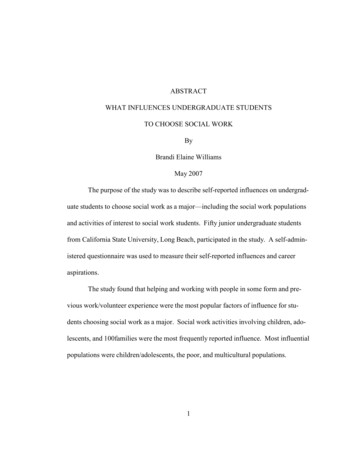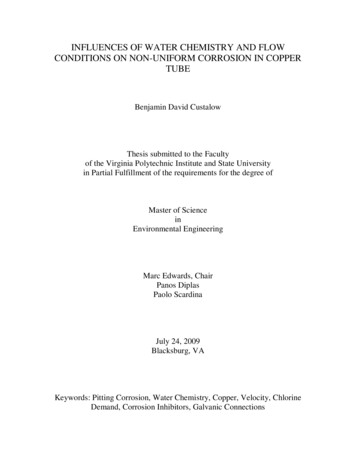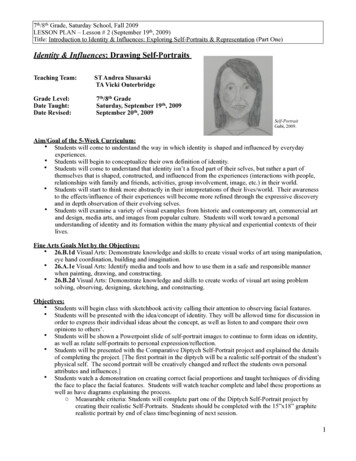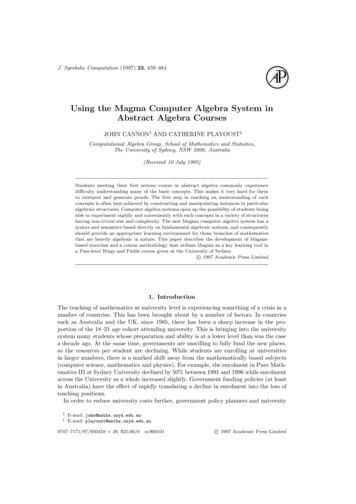
Transcription
ABSTRACTWHAT INFLUENCES UNDERGRADUATE STUDENTSTO CHOOSE SOCIAL WORKByBrandi Elaine WilliamsMay 2007The purpose of the study was to describe self-reported influences on undergraduate students to choose social work as a major—including the social work populationsand activities of interest to social work students. Fifty junior undergraduate studentsfrom California State University, Long Beach, participated in the study. A self-administered questionnaire was used to measure their self-reported influences and careeraspirations.The study found that helping and working with people in some form and previous work/volunteer experience were the most popular factors of influence for students choosing social work as a major. Social work activities involving children, adolescents, and 100families were the most frequently reported influence. Most influentialpopulations were children/adolescents, the poor, and multicultural populations.1
The study’s implication study was that an understanding of students’ interestsshould help with the development of effective recruitment techniques for social workschools and with alleviating the shortage of professional social workers.2
WHAT INFLUENCES UNDERGRADUATE STUDENTSTO CHOOSE SOCIAL WORKA ThesisPresented to the Department of Social WorkCalifornia State University, Long BeachIn Partial Fulfillmentof the Requirements for the DegreeMaster of Social WorkBy Brandi Elaine WilliamsB.A., 2003, University of San FranciscoMay 2007
WE, THE UNDERSIGNED MEMBERS OF THE COMMITTEE,HAVE APPROVED THIS THESISWHAT INFLUENCES UNDERGRADUATE STUDENTSTO CHOOSE SOCIAL WORKByBrandi Elaine WilliamsCOMMITTEE MEMBERSSusan Love, Ph.D. (Chair)Social WorkJillian Jimenez, Ph.D.Social WorkPhilip Tan, Ph.D.Social WorkACCEPTED AND APPROVED ON BEHALF OF THE UNIVERSITYJohn Oliver, Ph.D.Director, Department of Social WorkCalifornia State University, Long BeachMay 2007
ACKNOWLEDGMENTSThe past 3 years in the Master of Social Work program has been one of themost challenging times of my life, and I would not have completed this journey withoutthe continued support and guidance of my family and friends.My mother, Linda, has been a constant source of strength and support for me.She has been my cheerleader and my mentor during these 3 years. I am thankful for hersupport financially and emotionally in my search to improve myself academically andprofessionally. She is a true role model, and I am so proud to call her my mother.My father, Paul, was unable to see me achieve the completion of graduateschool. His passing has been a hard loss in my life, but I know that he is in a betterplace and is watching over me.Dr. Susan Love, my thesis advisor, has made this process manageable. I trulyappreciate her ability to keep on schedule, and I enjoyed working with her a great deal.I would also like to thank my thesis committee members, Dr. Jillian Jimenez and Dr.Phillip Tan, for their suggestions and assistance in completing this project.iii
CONTENTSPageACKNOWLEDGMENTS. . . . . . . . . . . . . . . . . . . . . . . . . . . . . . . . . . . . . . . . . . . . .iiiTABLES. . . . . . . . . . . . . . . . . . . . . . . . . . . . . . . . . . . . . . . . . . . . . . . . . . . . . . . . . .viCHAPTER1.2.3.INTRODUCTION. . . . . . . . . . . . . . . . . . . . . . . . . . . . . . . . . . . . . . . . . . . .1Statement of the Social Problem. . . . . . . . . . . . . . . . . . . . . . . . . . . . . .Purpose of the Study. . . . . . . . . . . . . . . . . . . . . . . . . . . . . . . . . . . . . . .Definition of Terms. . . . . . . . . . . . . . . . . . . . . . . . . . . . . . . . . . . . . . . .Career Aspirations. . . . . . . . . . . . . . . . . . . . . . . . . . . . . . . . . . . . .Influence. . . . . . . . . . . . . . . . . . . . . . . . . . . . . . . . . . . . . . . . . . . . .Values. . . . . . . . . . . . . . . . . . . . . . . . . . . . . . . . . . . . . . . . . . . . . . .112222REVIEW OF LITERATURE. . . . . . . . . . . . . . . . . . . . . . . . . . . . . . . . . . . .3Demographics and Prevalence of Social Work Students. . . . . . . . . . . .Shortage of Social Workers. . . . . . . . . . . . . . . . . . . . . . . . . . . . . . . . . .Social Work Students’ Influences. . . . . . . . . . . . . . . . . . . . . . . . . . . . .Career Aspirations of Social Work Students. . . . . . . . . . . . . . . . . . . . .Conclusion. . . . . . . . . . . . . . . . . . . . . . . . . . . . . . . . . . . . . . . . . . . . . . .35111419METHODOLOGY. . . . . . . . . . . . . . . . . . . . . . . . . . . . . . . . . . . . . . . . . . . .21Design. . . . . . . . . . . . . . . . . . . . . . . . . . . . . . . . . . . . . . . . . . . . . . . . . .Sample Selection. . . . . . . . . . . . . . . . . . . . . . . . . . . . . . . . . . . . . . . . . .Instrument. . . . . . . . . . . . . . . . . . . . . . . . . . . . . . . . . . . . . . . . . . . . . . .Data Collection. . . . . . . . . . . . . . . . . . . . . . . . . . . . . . . . . . . . . . . . . . .Data Analysis. . . . . . . . . . . . . . . . . . . . . . . . . . . . . . . . . . . . . . . . . . . . .2121212223iv
CHAPTER4.PageRESULTS. . . . . . . . . . . . . . . . . . . . . . . . . . . . . . . . . . . . . . . . . . . . . . . . . . .24Demographics and Descriptive Characteristics. . . . . . . . . . . . . . . . . . .Attitudes Regarding the Field of Social Work. . . . . . . . . . . . . . . . . . . .Level of Influence of Factors, Populations, and Activities onCareer Options. . . . . . . . . . . . . . . . . . . . . . . . . . . . . . . . . . . . . . . .2426DISCUSSION. . . . . . . . . . . . . . . . . . . . . . . . . . . . . . . . . . . . . . . . . . . . . . . .30Findings. . . . . . . . . . . . . . . . . . . . . . . . . . . . . . . . . . . . . . . . . . . . . . . . .Limitations and Recommendations for Future Research. . . . . . . . . . . .Implications for Social Work Practice. . . . . . . . . . . . . . . . . . . . . . . . . .303334APPENDICES. . . . . . . . . . . . . . . . . . . . . . . . . . . . . . . . . . . . . . . . . . . . . . . . . . . . . .35A. INFORMED CONSENT. . . . . . . . . . . . . . . . . . . . . . . . . . . . . . . . . . . . . . .36B. QUESTIONNAIRE. . . . . . . . . . . . . . . . . . . . . . . . . . . . . . . . . . . . . . . . . . .40REFERENCES CITED. . . . . . . . . . . . . . . . . . . . . . . . . . . . . . . . . . . . . . . . . . . . . . .455.v26
TABLESTABLEPage1.Demographic and Descriptive Characteristics of Respondents. . . . . . . . . .252.Attitudes Regarding the Field of Social Work, by Themes. . . . . . . . . . . . . .273.Professional Activities and Career Goals. . . . . . . . . . . . . . . . . . . . . . . . . . .284.Social Work Populations: Children/Adolescents. . . . . . . . . . . . . . . . . . . . .29vi
CHAPTER 1INTRODUCTIONStatement of the Social ProblemSocial work practice requires a high level of skill and training. It is the largestand the most diverse health profession in the United States (State University of NewYork [SUNY]-Albany and National Association of Social Workers [NASW], 2006).Social workers help in many areas of a person’s life including family, work, andmental health. Due to a severe shortage in qualified social workers in Los Angeles,less educated, nonsocial workers are being used to meet the need (Pasztor, SaintGermain, & DeCrescenzo, 2002). Undergraduate social work students represent apotential pool for future social workers. Undergraduate classes may be a student’s firstexposure to social work and its values. An understanding of the self-reported influences of undergraduate students’ interest in social work can be helpful with recruitingefforts to fill the needed gap.Purpose of the StudyThe purpose of this study was to describe the self-reported influences of undergraduate students to chose social work as a major and as their career aspirations. Theresearcher attempted to answer the following questions:1. What social work activities are of interest to social work students?1
2. What social work populations are of interest to social work students?3. What are the careers aspirations of interest to social work students?Definition of TermsCareer AspirationsFor the purpose of this study, defined as the goals and purpose that studentsexpressed toward their own professional career.InfluenceThose factors that affect or promote students’ interest to pursue social work.ValuesThe beliefs of the social work student with respect to an emotional investmentor agreed upon as a profession.2
CHAPTER 2REVIEW OF LITERATURESocial workers are highly trained professionals who seek to help people andsociety (Reid & Peebles-Wilkins, 1991). They can help individuals function better intheir environments, assist with family and personal difficulties, and improve their relationships with others. Social workers help people overcome some of life’s most difficult challenges: poverty, abuse, inequality, addiction, unemployment, and mentalillness (SUNY-Albany & NASW, 2006). Undergraduate social work students are animportant group to explore. These students are a feeder group for graduate social workprograms, and they also represent a significant prospect for future employment in thepublic and private sector.Demographics and Prevalence of Social Work StudentsCalifornia is a state that is ethnically and linguistically diverse (Planning theFuture, 2001). Unlike the population of California, the field of social work is lessethnically varied. In 2004, the majority of social workers indicated themselves to benon-Hispanic White (85%; SUNY-Albany & NASW, 2006). Change in this area isoccurring, but slowly. Social workers who are 30 years and younger are less likely toindicate themselves ethnically as non-Hispanic White and more likely to indicate“other.” The citizens of California need social workers who mirror the diversity3
around them. Another discrepancy within social work is that it is disproportionatelydominated by women. In a recent survey conducted by SUNY-Albany and NASW(2006) of licensed clinical social workers, 4 out of 5 (81%) respondents identifiedthemselves as women. The number of male social workers grew smaller in the younger age cohorts. If this trend continues, there will be fewer male social workers asolder male social workers age out of the system.Students with a bachelor’s degree in social work are prepared for entry-levelcase or group work with clients and their families. There have been a number of estimates on the graduation rates of students by social work schools. In the University ofCalifornia, Berkeley 1998 study of 13 social work programs in California, there werefewer then 5,000 social work students (as cited in California Assembly, Human Service Committee, 2002). Of that number, approximately half were in Master in SocialWork (M.S.W.) programs and the other half were in Bachelor in Social Work (B.S.W.)programs. In that same year 1,509 students graduated from those social work programs. Of those students, 35% earned their B.S.W. degree. Overall, the enrollment inB.S.W. programs has steadily increased while M.S.W. enrollment has remained stable(California Assembly, Human Service Committee).California State University, Long Beach (CSULB) has been a public institutionsince 1949. The undergraduate student population at CSULB has been estimated to be28,514 (“The 2007 Edition,” 2006). One program that is offered at CSULB for undergraduate students is social work. The Department of Social Work for CSULB offersfull-time and part-time models. In 2005, there were 111 undergraduate social work4
students enrolled at CSULB. Of that total, 69.37% were full-time students and 30.63%were part-time students (Candance M. Smith, Admissions Coordinator, CSULBDepartment of Social Work, personal communication, July 2006). Undergraduatesocial work programs are a valuable feeder for graduate social work programs. SUNYAlbany and NASW (2006) data indicated that 63% of social workers with B.S.W.degrees in the survey subsequently received a M.S.W. degree, although later B.S.W.degree recipients have been less likely to pursue M.S.W. degrees than earlier B.S.W.degree recipients. Of the 662 applicants who applied to CSULB in the fall of 2006 fora M.S.W. degree, 29 were applicants who graduated with a B.S.W. degree fromCSULB and 100 applicants had social work undergraduate degrees from other colleges(C. M. Smith, personal communication, July 2006). A B.S.W. degree provides students with a healthy understanding of human development and behavior. Social workschools have a vested interest in recruiting and producing social workers for the future.Shortage of Social WorkersSocial work is a large helping profession with an estimated number of 840,000practitioners, second only to registered nurses in terms of numbers of practitioners(SUNY-Albany & NASW, Albany, 2006). Social workers are hired by public agencies, nonprofit organizations, and for-profit organizations. In California, most of thesocial workers are employed at the county level (Pasztor et al., 2002). California produces fewer social work graduates per capita than other large states that also have ahigh level of demand for social workers (California Assembly Human Service Committee, 2002). The profession of social work in today’s market is facing the challenge5
of securing qualified social workers. The negative view that the public has of socialworkers, along with the poor pay, deters many potential social workers from enteringthe field (Pasztor et al.). Social workers are a resource used to distribute social services. The more social services that are needed by the public, the greater the demand forsocial workers.Social workers participate in a variety of fields such as mental health, childwelfare, developmental disabilities, and community planning. It is unfortunate thatwhile there are plentiful jobs available, there are not enough qualified social workers togo around (Pastor et al., 2002; SUNY-Albany & NASW, 2006). According to the U.S.Department of Labor (2006), job opportunities for social workers should increase 33%,compared with only 14% for all industries combined through the year 2014.There are several reasons for this projected need for social workers. Onereason is the anticipated services that will be needed for the aging baby boomer generation. Social work is 1 of the 20 professions that will be most affected by baby boomerretirements (SUNY-Albany & NASW). Just as the U.S. population is getting older, sois the current population of social workers. A second reason for the projected need insocial workers is that when the older social workers retire their will be a need for newsocial workers to be available to fill their positions. It has been estimated that therewill be a need for 54,000 more social workers just to balance out retirements for theperiod of 2003-2008 (SUNY-Albany & NASW).A third reason is that skilled social workers are necessary to help address adultchildren concerning their parents’ increasingly complex psychosocial needs and to help6
provide information and long-term care for elderly persons. Social workers areequipped to care for older adults in a wide range of settings by providing informationregarding navigating health and social services as well as choices in housing and transportation (Institute for Geriatric Social Work [IGSW] & New York Academy ofMedicine [NYAM], 2005). Social workers provide innumerable benefits to theirclients: “Patients reported greater satisfaction with their healthcare when a socialworker is involved, saying that the quality of their care improves and their level ofsocial interaction increases” (IGSW & NYAM, p. 1).There are many areas in social service that are experiencing a shortage. Thedemand for social workers will continue to increase across the board as the populationgrows and diversifies. An area that is experiencing a serious need of social workers isdevelopmental disabilities. Parents of children with developmental disabilities face thechallenge of finding affordable and accessible service. Regional centers in Californiacurrently serve about 170,000 clients. These centers experience a 5% annual growth inthe size of the population that they serve. Regional centers have a difficulty keepingsocial workers. Many social workers use their time working in the regional centers asa training opportunity. State regional centers currently have a 25% vacancy rate (California Assembly, Human Service Committee, 2001). This kind of high vacancy canresult in clients being assigned to staff that may not possess expertise concerning theclient's needs.Another area that is experiencing a shortage is mental health. Despite anincrease in funding for mental health (California Assembly, Human Service7
Committee, 2001), there is a disproportionate ratio of mentally ill individuals to mentalhealth professionals of 4,500:1 (California Mental Health Planning Council, 2003).The statewide public mental health system has a vacancy rate reaching 22% for licensed clinical social workers (L.C.S.W.s) and M.S.W.s combined (California Assembly, Human Service Committee). A common response from social workers in thisfield is that they feel dispirited by the constant revolving door of clients and the need torestrain them (Reid et al., 1999). It can take weeks for some agencies to fill just onevacant position in this field.Another area that is experiencing a shortage is child welfare. Vacancy rates inChild Protective Services in California have been about 9.5% (Pasztor et al., 2002). Ithas been estimated that California will need 3,400 new social workers to fill thesevacancies, which are 50% more than the number they currently have (CaliforniaAssembly, Human Service Committee, 2001). A factor in the increasing need for childwelfare social workers is that there are better reporting and monitoring procedures thathave increased the number of child abuse reports and children in the system (Pasztor etal.). More social workers are needed to respond to these reports and help prevent children and families from entering into the system in the first place. Certain laws mandate that social workers achieve specific goals in a certain time frame. A high vacancyrate in the child welfare system makes it increasingly hard for present social workers tomeet those goals. In addition, the need for social workers in Adult Protective Services(APS) has drained workers from the child welfare system (California Assembly,Human Service Committee).8
Another area that is experiencing a shortage is gerontology. The elderly population is growing increasingly. Aging and long term care has vacancies rates of 20% to30%. Obstacles to the recruitment of social workers in this area are the lack of candidates willing to work for the low pay and the lack of diversity among these candidates(California Assembly, Human Service Committee, 2001). APS, a department thattackles older adults’ needs, is required to operate 24 hours a day. In Los AngelesCounty, the APS caseload has increased significantly over the past few years (California Assembly, Human Service Committee). The role that APS provides has expandedfrom that of crisis intervention to crisis management. The shortage in social workers isaffecting many areas, but in order to solve this problem, one must know the reasonsbehind it. There have been many reasons postulated for the continued shortage insocial workers. Reasons that have been given include “increase in paperwork, [increase in] caseload size, severity in client problems, and level of oversight” (SUNYAlbany & NASW, 2006, p. 10). Job recruitment is hampered by high caseloads andmore attractive job alternatives. SUNY-Albany and NASW reported that nearly 75%of their respondents cited a higher salary as being a major influence in changing theircurrent job.A reason given for the shortage in social workers is high turnover. Publicagencies experience an average turnover rate of up to 20% per year (Pasztor et al.,2002). Individuals change caree
CSULB and 100 applicants had social work undergraduate degrees from other colleges (C. M. Smith, personal communication, July 2006). A B.S.W. degree provides stu-dents with a healthy understanding of human development and behavior. Social work











